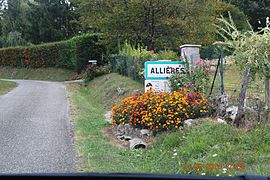Allières: Difference between revisions
m Remove unused region and department parameters from Template:Infobox French commune to prevent confusion INSEE field is used now. See Wikipedia:Bots/Requests_for_approval/Lonjers_french_region_rename_bot |
|||
| Line 21: | Line 21: | ||
}} |
}} |
||
'''Allières''' is a French [[Communes of France|commune]] in the [[Ariège (department)|Ariège]] [[Departments of France|department]] in the [[ |
'''Allières''' is a French [[Communes of France|commune]] in the [[Ariège (department)|Ariège]] [[Departments of France|department]] in the [[Occitanie]] region of southwestern [[France]]. |
||
The inhabitants of the commune are known as ''Alliérasois'' or ''Alliérasoises''<ref>[http://www.habitants.fr/habitants_departement_ariege_09.html Inhabitants of Ariège] {{fr icon}}</ref> |
The inhabitants of the commune are known as ''Alliérasois'' or ''Alliérasoises''<ref>[http://www.habitants.fr/habitants_departement_ariege_09.html Inhabitants of Ariège] {{fr icon}}</ref> |
||
Revision as of 05:24, 12 November 2016
Allières | |
|---|---|
 The road into Allières | |
| Country | France |
| Region | Occitania |
| Department | Ariège |
| Arrondissement | Foix |
| Canton | La Bastide-de-Sérou |
| Intercommunality | Seronnais 117 |
| Government | |
| • Mayor (2008–2020) | Denis Puech |
Area 1 | 9.1 km2 (3.5 sq mi) |
| Population (2009) | 62 |
| • Density | 6.8/km2 (18/sq mi) |
| Time zone | UTC+01:00 (CET) |
| • Summer (DST) | UTC+02:00 (CEST) |
| INSEE/Postal code | 09007 /09240 |
| Elevation | 347–652 m (1,138–2,139 ft) (avg. 550 m or 1,800 ft) |
| 1 French Land Register data, which excludes lakes, ponds, glaciers > 1 km2 (0.386 sq mi or 247 acres) and river estuaries. | |
Allières is a French commune in the Ariège department in the Occitanie region of southwestern France.
The inhabitants of the commune are known as Alliérasois or Alliérasoises[1]
Geography
Allières is located in the Plantaurel mountains in the Natural Regional Park of Pyrénées ariégeoises some 22 km west by north-west of Foix and some 70 km south of Toulouse. Access to the commune is by the minor D49 road which runs north from the D117 road through the commune and the village and continuing north across the mountains to join the D119 near Maury. There is also access by a minor road from the east. Apart from the village there is also the hamlet of Escougnale. The commune is heavily forested with a few farms.[2]
Numerous streams rise in the commune mostly flowing north to the Ruisseau de Mourisse which forms the northern border of the commune and flows west to join the Arize river near Maury. There is also the Ruisseau de Peydalières rising in the west of the commune which flows west also to join the Arize.[2]
Neighbouring communes and villages[2]
Administration
List of Successive Mayors[3]
| From | To | Name | Party | Position |
|---|---|---|---|---|
| 2001 | 2020 | Denis Puech |
(Not all data is known)
Demography
In 2009 the commune had 62 inhabitants. The evolution of the number of inhabitants is known through the population censuses conducted in the commune since 1793. From the 21st century, a census of communes with fewer than 10,000 inhabitants is held every five years, unlike larger towns that have a sample survey every year.[Note 1]
Template:Table Population Town



Culture and heritage
Religious heritage
The Parish Church of Saint Roche contains two items that are registered as historical objects:
- A Painting with frame: Presentation at the temple of the child Jesus with a saint bishop (17th century)
 [4]
[4] - A Painting with frame: Virgin and child surrounded by Saint Julien and Saint Nicolas de Myre (1871)
 [5]
[5]
Notable people linked to the commune
The Falentin Saintenac family has many dead in their chapel adjoining the church.
See also
- Communes of the Ariège department
- Cantons of the Ariège department
- Arrondissements of the Ariège department
External links
- Allières on the National Geographic Institutre website Template:Fr icon
- Allières on Lion1906
- Allières on Google Maps
- Allières on Géoportail, National Geographic Institute (IGN) website Template:Fr icon
- Ailleres on the 1750 Cassini Map
- Allières on the INSEE website Template:Fr icon
- INSEE Template:Fr icon
Notes and references
Notes
- ^ At the beginning of the 21st century, the methods of identification have been modified by law No. 2002-276 of 27 February 2002 [1], the so-called "law of local democracy" and in particular Title V "census operations" which allow, after a transitional period running from 2004 to 2008, the annual publication of the legal population of the different French administrative districts. For communes with a population greater than 10,000 inhabitants, a sample survey is conducted annually, the entire territory of these communes is taken into account at the end of the period of five years. The first "legal population" after 1999 under this new law came into force on 1 January 2009 and was based on the census of 2006.
References
- ^ Inhabitants of Ariège Template:Fr icon
- ^ a b c Google Maps
- ^ List of Mayors of France
- ^ Ministry of Culture, Palissy IM09000116 Painting with frame: Presentation at the temple of the child Jesus with a saint bishop Template:Fr icon
- ^ Ministry of Culture, Palissy IM09000115 Painting with frame: Virgin and child surrounded by Saint Julien and Saint Nicolas de Myre Template:Fr icon

